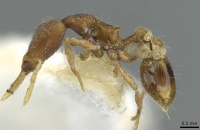Strumigenys aduncomala
| Strumigenys aduncomala | |
|---|---|

| |
| Scientific classification | |
| Kingdom: | Animalia |
| Phylum: | Arthropoda |
| Class: | Insecta |
| Order: | Hymenoptera |
| Family: | Formicidae |
| Subfamily: | Myrmicinae |
| Tribe: | Attini |
| Genus: | Strumigenys |
| Species: | S. aduncomala |
| Binomial name | |
| Strumigenys aduncomala De Andrade, 2007 | |
Nothing is known about the biology of Strumigenys aduncomala.
Identification
Baroni Urbani & De Andrade (2007) - A member of the caniophanes complex in the Strumigenys caniophanes-group. Resembling Strumigenys lacunosa but differing from it by the dorsolateral margin of the head with 2 instead of 3 hairs projecting laterally, by its smaller size (TL = 2.52 mm instead of 3.1 mm) and by the lower MI (43.7 instead of 50).
Among the 12 species of the caniophanes-complex, aduncomala resembles more Strumigenys lacunosa. S. aduncomala and lacunosa share the apical funicular segment moderately constricted basally, the dorsum of the pronotum with at least 2 pairs of erect hairs and the dorsum of the mesonotum with about 4 pairs of erect hairs. At first glance S. aduncomala superficially resembles Strumigenys exilirhina in general body shape, for having the dorsolateral margin of the head in full-face view with 2 projecting hairs, and for the basal constriction of the apical funicular antennomere. But exilirhina belongs to the mayri-group whose component species are characterized mainly by the anterior clypeal margin with a U-shaped or V -shaped median notch and by the apical antennomere strongly constricted basally. S. aduncomala has the anterior clypeal margin straight and the apical antennomere moderately constricted basally.
Keys including this Species
Distribution
Distribution based on Regional Taxon Lists
Oriental Region: India (type locality).
Distribution based on AntMaps
Distribution based on AntWeb specimens
Check data from AntWeb
Countries Occupied
| Number of countries occupied by this species based on AntWiki Regional Taxon Lists. In general, fewer countries occupied indicates a narrower range, while more countries indicates a more widespread species. |

|
Estimated Abundance
| Relative abundance based on number of AntMaps records per species (this species within the purple bar). Fewer records (to the left) indicates a less abundant/encountered species while more records (to the right) indicates more abundant/encountered species. |

|
Biology
Castes
Nomenclature
The following information is derived from Barry Bolton's Online Catalogue of the Ants of the World.
- aduncomala. Strumigenys aduncomala De Andrade, in Baroni Urbani & De Andrade, 2007: 150, fig. 52 (w.) INDIA.
Unless otherwise noted the text for the remainder of this section is reported from the publication that includes the original description.
Description
Worker
TL 2.52; HL 0.64; HW 0.46; SL 0.34; ML 0.28; EL 0.04; WL 0.69; CI 71.9; SI 73.9; MI 43.7.
Head converging anteriorly, with round vertexal corners. Frontal lobes weakly expanded and convex. Antennal fossae ventrally with a narrow carina visible in full-face view, straight, not covering the lower margin of the scrobes and ending much before the eyes. Eyes small, with 3-4 ommatidia in the longest row, placed over the ventral margin of the antennal scrobes, and visible in dorsal view. With head in profile the scrobe distinct, with weakly marked upper and lower margins. Lateral clypeal margins gently converging anteriorly into a straight margin. Scapes subcylindrical, about 1/2 of the head length and surpassing the eyes posteriorly. Antennae with six joints. Apical funicular joint moderately constricted basally and longer than the rest of the funiculus. Mandibles curved. Apical fork of the mandible with two spiniform teeth, the apicodorsal larger; space between the apical teeth bearing one intercalary denticle. Preapical dentition consisting of one tooth.
Mesosoma in profile weakly convex anteriorly and sloping posteriorly. Propodeal teeth pointed; declivous propodeal face marginate only. Mesepisternal hair beds large but smaller than the maximum width of the fore coxa.
Petiole with a long neck and round node. Ventral surface of the petiole with a broad spongiform lamina. Petiolar node with posterior sides and posterior margin surrounded by spongiform process. Postpetiole gently convex in side view. Anterior, lateral and posterior faces of the postpetiole surrounded by spongiform processes broader posteriorly. Ventral surface of the postpetiole with large and dense spongiform process.
Gaster oval and with thin, short costulae. Base of the first gastral tergite and sternite with spongiform pad larger on the tergite.
Sculpture. Head, dorsum of the mesosoma, propleurae and petiole densely reticulate-punctuate. Postpetiole with very sparse, superficial punctures. Meso- and metapleurae and gaster smooth.
Pilosity. Head, mesosoma, petiole and postpetiole with appressed, thin, hairs. Dorsolateral margin of the head in full-face view with 2 freely laterally projecting flagellate hairs, one in apicoscrobal position and one just posterior to the eye. Cephalic dorsum with a transverse row of 4 erect fine hairs along the occipital margin, and with 2 pairs of similar hairs anterior to this, the anterior pair shorter and on the frons and the posterior pair on the middle of the occipital lobes. Pronotal humeral hairs flagellate and long. Dorsum of the pronotum with two pairs of erect fine hairs. Dorsum of the mesonotum with 4 pairs of erect flagellate hairs, the anterior and posterior pairs shorter. Dorsum of the propodeum with rare sub decumbent fine hairs. Petiolar node with three pairs of fine hairs, the posterior pair longer and flagellate. Postpetiole and gaster with long flagellate hairs. Femora and tibiae with a few erect or suberect hairs. Mid- and hind basitarsi with 2 long fine erect hairs.
Colour. Light brownish.
Type Material
Holotype worker (unique) from India labelled: Upper Shillong, 1900 m, 13.V.1976, Meghalaya, W. Wittmer & C. Baroni Urbani (Naturhistorisches Museum, Basel).
Etymology
From the Latin aduncus (= curved), and mala (= mandible), referred to the very curved shape of the mandibles.

